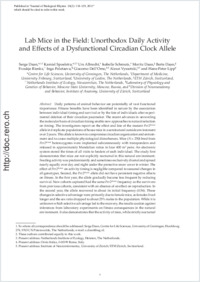Lab mice in the field: unorthodox daily activity and effects of a dysfunctional circadian clock allele
- Spoelstra, Kamiel Centre for Life Sciences, University of Groningen, The Netherlands
- Albrecht, Urs Department of Medicine, University of Fribourg, Switzerland
- Schmutz, Isabelle Department of Medicine, University of Fribourg, Switzerland
- Daan, Moritz Department of Medicine, University of Fribourg, Switzerland
- Daan, Berte ETH Zürich, Switzerland
- Rienks, Froukje Netherlands Institute of Ecology, Nieuwersluis, The Netherlands
- Poletaeva, Inga Laboratory of Physiology and Genetics of Behavior, Moscow State University, Moscow, Russia
- Dell'Omo, Giacomo Division of Neuroanatomy and Behavior, Institute of Anatomy, University of Zürich, Switzerland
- Vyssotski, Alexei Division of Neuroanatomy and Behavior, Institute of Anatomy, University of Zürich, Switzerland
- Lipp, Hans-Peter Division of Neuroanatomy and Behavior, Institute of Anatomy, University of Zürich, Switzerland
-
2011
Published in:
- Journal of Biological Rhytms. - 2011, vol. 26, no. 2, p. 118-129
English
Daily patterns of animal behavior are potentially of vast functional importance. Fitness benefits have been identified in nature by the association between individual timing and survival or by the fate of individuals after experimental deletion of their circadian pacemaker. The recent advances in unraveling the molecular basis of circadian timing enable new approaches to natural selection on timing. The investigators report on the effect and fate of the mutant Per2Brdm1 allele in 4 replicate populations of house mice in a seminatural outside environment over 2 years. This allele is known to compromise circadian organization and entrainment and to cause multiple physiological disturbances. Mice (N = 250) bred from Per2Brdm1 heterozygotes were implanted subcutaneously with transponders and released in approximately Mendelian ratios in four 400 m² pens. An electronic system stored the times of all visits to feeders of each individual. The study first demonstrates that mice are not explicitly nocturnal in this natural environment. Feeding activity was predominantly and sometimes exclusively diurnal and spread nearly equally over day and night under the protective snow cover in winter. The effect of Per2Brdm1 on activity timing is negligible compared to seasonal changes in all genotypes. Second, the Per2Brdm1 allele did not have persistent negative effects on fitness. In the first year, the allele gradually became less frequent by reducing survival. New cohorts captured had the same Per2Brdm1 frequency as the survivors from previous cohorts, consistent with an absence of an effect on reproduction. In the second year, the allele recovered to about its initial frequency (0.54). These changes in selective advantage were primarily due to female mice, as females lived longer and the sex ratio dropped to about 25% males in the population. While it is unknown which selective advantage led to the recovery, the results caution against inferences from laboratory experiments on fitness consequences in the natural environment. It also demonstrates that the activity of mice, while strictly nocturnal in the laboratory, may be partially or completely diurnal in the field. The new method allows assessment of natural selection on specific alleles on a day-today basis.
- Faculty
- Faculté des sciences et de médecine
- Department
- Département de Biologie
- Language
-
- English
- Classification
- Biological sciences
- License
-
License undefined
- Identifiers
-
- RERO DOC 27911
- DOI 10.1177/0748730410397645
- Persistent URL
- https://folia.unifr.ch/unifr/documents/302254
Statistics
Document views: 103
File downloads:
- pdf: 260
